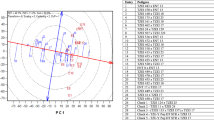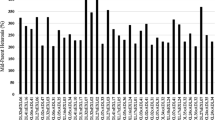Abstract
Drought occurs at high frequency in maize production zones in Africa. Carefully controlled moisture deficits have been imposed at anthesis and grain filling stages of maize to develop drought tolerant germplasm. The present study was conducted to examine the potential effects of drought tolerant parents selected under such managed drought stress on agronomic performance of their top-cross hybrids across variable growing conditions in the rainy season. Three independent trials consisting of top-cross hybrids involving drought tolerant parents and commercial hybrids were evaluated under manged drought stress (MDS) and well watered (WW) condition at Ikenne in Nigeria for 3 years during the dry season and across 30 stressful (SE) and 52 favourable (FE) rainfed environments in West Africa. The drought stress imposed in the dry season caused a 53–64 % annual average yield reductions in these trials. In spite of these, about 56 % of the top-crosses produced high grain yields under MDS and WW conditions. The rank orders for hybrid grain yields did not change markedly across different years under MDS and WW conditions. Also, nearly 78 % of the top-crosses produced high grain yields across SE and FE environments in the rainy season. Sixteen top-cross hybrids amongst these were present in the top yielding groups under the MDS environment. Some high yielding top-crosses with stable performance across variable rainfed environments were identified in the current study. The phenotypic and genetic correlations between grain yield under MDS and that under SE environment were positive and moderate. Also, the phenotypic and genetic correlations showed that the capacity of top-cross hybrids to produce high grain yields under MDS was independent of the yield potential under FE environment. These results suggest that selection of parents under manged drought stress promotes the development of top-cross hybrids broadly adapted to variable rainfed conditions.




Similar content being viewed by others
References
Ali ML, Luetchens J, Singh A, Shaver TM, Kruger GR, Lorenz AJ (2015) Greenhouse screening of maize genotypes for deep root mass and related root traits and their association with grain yield under water-deficit conditions in the field. Euphytica 207:79–94
Alvarado, Gregorio; López, Marco; Vargas, Mateo; Pacheco, Ángela; Rodríguez, Francisco; Burgueño, Juan; Crossa, José (2015) “META-R (Multi environment trial analysis with R), Version 5.0”, http://hdl.handle.net/11529/10201
Bänziger M, Setimela PS, Hodson D, Vivek B (2006) Breeding for improved drought tolerance in maize adapted to southern Africa. Agric Water Manag 80:212–224
Betran FJ, Beck D, Banziger M, Edmeades GO (2003) Genetic analysis of inbred and hybrid grain yield under stress and nonstress environments in tropical maize. Crop Sci 43:807–817
Bidinger FR, Raj AGB, Abraha N, Ali AM, Obilana AB, Jones RB (2005) Topcross hybrids as an entry into commercial seed production of Pearl Millet in Eastern Africa. Expl Agric 41:335–356. doi:10.1017/S001447970500267X
Blum A (1997) Constitutive traits affecting plant performance under stress. In: Edmeades GO et al (eds) Developing drought- and low N-tolerant maize. CIMMYT/UNDP, Mexico, pp 415–525
Bruce BW, Gregory OE, Barker TC (2002) Molecular and physiological approaches to maize improvement for drought tolerance. J Exp Bot 53:13–25
Byrne PF, Bolanos J, Edmeades GO, Eaton DL (1995) Gains from selection under drought versus multilocation testing in related tropical maize populations. Crop Sci 35:63–69
Campos H, Cooper M, Habben JE, Edmeades GO, Schussler JR (2004) Improving drought tolerance in maize: a view from industry. Field Crops Res 90:19–34
Castleberry RM, Crum CW, Krull CF (1984) Genetic yield improvement of US cultivars under varying fertility and climatic environments. Crop Sci 24:33–36
Ceccarelli S (1994) Specific adaptation and breeding for marginal conditions. Euphytica 77:205–219. doi:10.1007/BF02262633
Ceccarelli S (1996) Adaptation to low/high input cultivation. Euphytica 92:203–214. doi:10.1007/BF00022846
Chaves MM, Maroco JP, Pereira JS (2003) Understanding plant responses to drought from genes to the whole plant. Funct Plant Bio 30:239–264
Duvick DN (2005) Genetic progress in yield of united states maize (Zea mays L.). Maydica 50:193–202
Eberhart SA, Russell WA (1969) Yield and stability for a 10-line diallel of single cross and double cross hybrids. Crop Sci 9:357–361
Edmeades GO, Bolaños J, Bänziger M, Chapman SC, Ortega AC, Lafitte HR, Fischer KS, and Pandey S (1997) Recurrent selection under managed drought stress improves grain yields in tropical maize. In: Edmeades GO, Bänziger M, Mickelson HR, Peña-Valdivia CB (eds) Developing drought and low N-tolerant maize. Proceedings of a Symposium, March 25–29, 1996. CIMMYT, El Batán, Mexico, DF, pp 415–425
Edmeades GO (2008) Drought tolerance in maize: an emerging reality. In: James C (ed) Brief 39 Global status of commercialized biotech/GM crops. ISAAA, Ithaca, pp 197–217
Edmeades GO (2013) Progress in Achieving and Delivering Drought Tolerance in Maize—An Update. ISAAA, Ithaca
Fajemisin J, Efron Y, Kim SK, Khadr FH, Dabrowski ZT, Mareck JH, Bjarnason M, Parkinson V, Everett LA, Diallo A (1985) Population and varietal development in maize for tropical Africa through resistance breeding approach. In: Brandolini A, Salamini F (eds) Breeding strategies for maize production improvement in the tropics. FAO and Istituto Agronomico per L’Oltremare, Florence, pp 385–407
FAOSTAT (2014) Crop production. FAOSTAT database
Fox PN, Skovmand B, Thompson BK, Braun HJ, Cormier R (1990) Yield and adaptation of hexaploid spring triticale. Euph 47:57–64
Hallauer AR (1991) Use of genetic variation for breeding population in cross-pollinated species. In: Stalker HT, Murphy JP (eds) Plant breeding in the 1990s. CAB International, Wallingford, pp 37–67
Haro von Mogel K (2013) Interactions key to beating future droughts. CSA News 58:4–9. doi:10.2134/csa2013-58-2-1
Heisey PW, Edmeades GO (1999) Part 1 of CIMMYT 1997/98 World maize facts and trends—maize production in drought-stressed environments: technical options and research resource allocation. CIMMYT, Mexico
Hunn M, Pierpho HP (1994) Relationships between kendall’s coefficient of concordance and a nonparametric measure of phenotypic stability with implications for the consistency in rankings as affected by variance components. Biom J 36(6):719–727
Institute SAS (2001) Statistical analysis software (SAS). Users guide, SAS Inst Inc., Cary
Jarvis A, Lau C, Cook S, Wollenberg E, Hansen J, Bonilla O, Challinor A (2011) An integrated adaptation and mitigation framework for developing agricultural research: synergies and trade-offs. Exp Agric 47:185–203
Jones DF (1958) Heterosis and homeostasis in evolution and in applied genetics. Am Nat 92:321–328
Kang MS, Pham HN (1991) Simultaneous selection for high yielding and stable crop genotypes. Agron J 83:161–165
Lorenzana RE, Bernardo R (2008) Genetic correlation between corn performance in organic and conventional production systems. Crop Sci 48:903–910
Louwaars NP, de Boef WS (2013) Integrated seed sector development in Africa: a conceptual framework for creating coherence between practices, programs, and policies. J Crop Imp 26(1):39–59
Ludlow MM, Muchow RC (1990) A critical evaluation of traits for improving crop yields in water-limited environments. Adv Agron 43:107–153
Masih I, Maskey S, Mussá FEF, Trambauer P (2014) A review of droughts on the African continent: a geospatial and long-term perspective hydrol earth. Syst Sci 18:3635–3649
Menkir A, Akintunde AO (2001) Evaluation of the performance of maize hybrids, improved open-pollinated and farmers’ local varieties under well-watered and drought stress conditions. Maydica 46:227–238
Meseka SK, Menkir A, Ajala S (2011) Genetic analysis of performance of maize inbred lines under drought stress. J Crop Imp 25:521–539
Monneveux P, Sanchez C, Tiessen A (2008) Future progress in drought tolerance in maize needs new secondary traits and cross combinations. J Agric Sci 146:1–14
Morris ML (2002) Impacts of international maize breeding research in developing countries, 1966–1998. CIMMYT, Mexico DF
Muñoz P, Carlos G, Henry T, Richard GA, James LW, Dale TW, Singh SP (2006) Selection for drought resistance in dry bean landraces and cultivars. Crop Sci 46:2111–2120
Pingali PL (ed) (2001) CIMMYT 1999–2000 World maize facts and trends. Meeting World maize needs: Technological opportunities and priorities for the public sector. CIMMYT, Mexico
Pixley KV (2006) Hybrid and open-pollinated varieties in modern agriculture. In: Lamkey KR, Lee M (eds) Plant breeding: the Hallauer AR International Symposium. Blackwell, Ames, pp 234–250
Shi W, Tao F (2014) Vulnerability of African maize yield to climate change and variability during 1961–2010. Food Sec 6:471–481
Shiferaw B, Tesfaye k, Kassie M, Abate T, Prasanna BM, Menkir A (2014) Managing vulnerability to drought and enhancing livelihood resilience in sub-Saharan Africa: technological, institutional and policy options. Weather Clim Extrem 3:67–79 ISSN 2212-0947
Shlomi A, Efron Y (1976) Variety x Line Cross—A Suggested Breeding Procedure for Maize in Developing Countries. Theor Appl Genet 48:255–260
Shroyer JP, Cox TS (1993) Productivity and adaptive capacity of winter wheat landraces and modern cultivars grown under low-fertility conditions. Euphytica 70:27–33
Shukla GK (1972) Some statistical aspects of partitioning genotype-environmental components of variability. Heredity 29:237–245
Smale M, Byerlee D, Jayne T (2011) Maize revolutions in Sub-Saharan Africa. Policy Research working paper 5659. World Bank, Washington, D.C.
Tahirou A, Diakalia S, Langyintuo A, Bamire SA, Adetunji O (2009) Assessing the constraints affecting production and deployment of maize seed in DTMA countries of West Africa. IITA, Ibadan, p 40
Van Amestel H, Bottema JWT, Sidik M, van Santen CE (1996) Integrating seed systems for annual food crops. In Proceedings of a workshop, 24–27 October1995, Malang, Indonesia. Bogor, Indonesia: CGPRT Center
Van Oosterom EJ, Weltzien E, Yadav OP, Bidinger FR (2006) Grain yield components of pearl millet under optimum conditions can be used to identify germplasm with adaptation to arid zones. Field Crops Res 96:407–421
Vargas M, Combs E, Alvarado G, Atlin G, Mathews K, Crossa J (2013) META: a suite of SAS programs to analyze multienvironment breeding trials. Agron J 105:11–19
Virk DS, Pandit DB, Sufian MA, Ahmed F, Siddique MAB, Samad MA, Rahman MM, Islam MM, Ortiz-Ferrara G, Joshi KD, Witcombe JR (2009) REML is an effective analysis for mixed modelling of unbalanced on-farm varietal trials. Expl Agric 45:77–91
Weatherspoon JH (1970) Comparative yield of single, three-way, and double crosses of maize. Crop Sci 10:157–159
Weber VS, Melchinger AE, Magorokosho C, Makumbi D, Banziger M, Atlin GN (2012) Efficiency of managed-stress screening of elite maize hybrids under drought and low nitrogen for yield under rainfed conditions in Southern Africa. Crop Sci 52:1011–1020
Williams TV, Snell RS, Cress CE (1969) Inheritance of drought tolerance in sweet corn. Crop Sci 9:19–22
Windhausen VS, Wagener S, Magorokosho C, Makumbi D, Bindiganavile V, Piepho HP, Melchinger AE, Atlin GN (2012) Strategies to subdivide a target population of environments: results from the CIMMYT led maize hybrid testing programs in Africa. Crop Sci 52:2143–2152
Xangsayasane P, Fukai S, Mitchell JH, Jongdee B, Jothityangkoon D, Pantuwan Inthapanya GP (2014) Genotypic performance in multi-location on-farm trials for evaluation of different on-station screening methods for drought-prone rainfed lowland rice in Lao PDR. Field Crops Res 160:1–11
Acknowledgments
This collaborative research between the International Institute of Tropical Agriculture (IITA) and the national agricultural research systems (NARS) in West Africa was financed by the Drought Tolerant Maize for Africa project. The authors express their appreciation to technical staffs working in the NARS and at IITA for participating during planting and management of these trials and recording the required data for 3 years.
Author information
Authors and Affiliations
Corresponding author
Electronic supplementary material
Below is the link to the electronic supplementary material.
Rights and permissions
About this article
Cite this article
Menkir, A., Crossa, J., Meseka, S. et al. Comparative performance of top-cross maize hybrids under managed drought stress and variable rainfed environments. Euphytica 212, 455–472 (2016). https://doi.org/10.1007/s10681-016-1777-0
Received:
Accepted:
Published:
Issue Date:
DOI: https://doi.org/10.1007/s10681-016-1777-0




